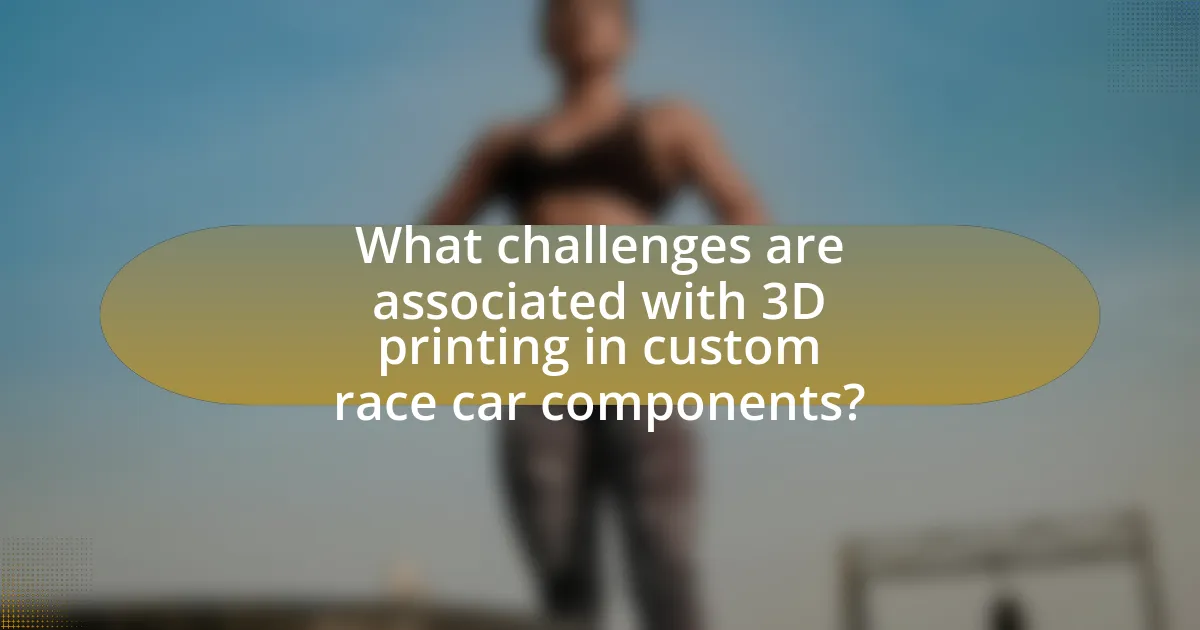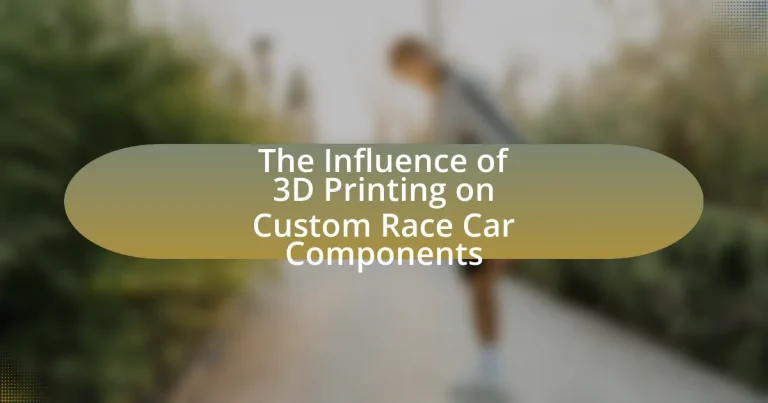The article examines the significant influence of 3D printing on custom race car components, highlighting its role in enabling rapid prototyping, lightweight designs, and complex geometries that traditional manufacturing cannot achieve. It discusses the evolution of 3D printing technology in the automotive industry, key advancements in materials and techniques, and the impact of customization on race car performance and strategy. Additionally, the article addresses challenges such as material limitations and regulatory compliance, while outlining best practices for successful implementation in racing. Future trends, including advancements in materials science and the integration of artificial intelligence, are also explored, emphasizing the transformative potential of 3D printing in enhancing race car design and production efficiency.

What is the Influence of 3D Printing on Custom Race Car Components?
3D printing significantly influences custom race car components by enabling rapid prototyping and production of lightweight, complex geometries that traditional manufacturing methods cannot achieve. This technology allows engineers to design and produce parts tailored to specific performance requirements, enhancing aerodynamics and reducing weight, which are critical in racing. For instance, teams can create custom intake manifolds or brackets that optimize airflow and structural integrity, leading to improved vehicle performance. Additionally, 3D printing reduces lead times and costs associated with producing low-volume, specialized components, allowing teams to iterate designs quickly and efficiently.
How has 3D printing technology evolved in the automotive industry?
3D printing technology has evolved significantly in the automotive industry by enabling rapid prototyping, customization, and production of lightweight components. Initially, 3D printing was primarily used for prototyping, allowing manufacturers to create and test designs quickly, which reduced development time and costs. Over the years, advancements in materials and printing techniques have expanded its applications to include the production of functional parts, such as engine components and custom race car elements. For instance, companies like Local Motors have successfully produced entire vehicles using 3D printing, showcasing the technology’s capability to create complex geometries that traditional manufacturing methods cannot achieve. Additionally, the use of metal 3D printing has allowed for the production of stronger, lighter parts, which is crucial in the performance-driven automotive sector.
What are the key advancements in 3D printing relevant to race car components?
Key advancements in 3D printing relevant to race car components include the development of high-performance materials, such as carbon fiber-reinforced polymers and metal alloys, which enhance strength and reduce weight. These materials allow for the production of complex geometries that traditional manufacturing methods cannot achieve, leading to improved aerodynamics and performance. Additionally, advancements in additive manufacturing techniques, such as selective laser sintering and fused deposition modeling, enable faster prototyping and production of custom parts, significantly reducing lead times. For instance, companies like Stratasys and EOS have demonstrated the ability to produce functional prototypes and end-use parts that meet the rigorous demands of motorsport applications, showcasing the practical benefits of these technologies in real-world racing scenarios.
How do these advancements impact the design process of race cars?
Advancements in 3D printing significantly enhance the design process of race cars by enabling rapid prototyping and customization of components. This technology allows engineers to create complex geometries that were previously impossible or cost-prohibitive with traditional manufacturing methods. For instance, teams can quickly iterate designs based on performance data, reducing the time from concept to track. Additionally, 3D printing facilitates the production of lightweight parts, which can improve speed and fuel efficiency, as evidenced by the use of 3D-printed components in Formula 1, where teams have reported weight reductions of up to 30%. This integration of advanced manufacturing techniques streamlines the overall design workflow, allowing for more innovative and efficient race car designs.
Why is customization important in race car components?
Customization is important in race car components because it allows for the optimization of performance, safety, and aerodynamics tailored to specific racing conditions. Tailored components can enhance speed, handling, and driver comfort, which are critical in competitive racing environments. For instance, a study by the Society of Automotive Engineers highlights that custom-designed parts can reduce weight and improve structural integrity, leading to faster lap times and better fuel efficiency. This level of customization is increasingly facilitated by advancements in 3D printing technology, which enables rapid prototyping and production of unique components that meet the precise needs of a race team.
What advantages does customization provide for race car performance?
Customization significantly enhances race car performance by allowing for tailored modifications that optimize speed, handling, and aerodynamics. Specific adjustments, such as lightweight components and precise tuning of suspension systems, can lead to improved acceleration and cornering capabilities. For instance, a study by the Society of Automotive Engineers found that custom-designed parts produced through 3D printing can reduce weight by up to 30%, directly impacting lap times and overall vehicle dynamics. Additionally, customization enables the integration of advanced materials that improve durability and reduce drag, further enhancing performance on the track.
How does customization affect the overall racing strategy?
Customization significantly enhances overall racing strategy by allowing teams to tailor vehicle components to specific track conditions and driver preferences. This adaptability leads to improved performance metrics, such as acceleration, handling, and aerodynamics. For instance, teams utilizing 3D printing can rapidly prototype and produce lightweight, optimized parts that directly influence lap times and fuel efficiency. A study by the Society of Automotive Engineers highlights that customized components can reduce vehicle weight by up to 20%, thereby increasing speed and maneuverability. This strategic advantage enables teams to respond dynamically to varying race scenarios, ultimately improving their competitive edge.
What role does 3D printing play in the production of custom race car components?
3D printing plays a crucial role in the production of custom race car components by enabling rapid prototyping and manufacturing of complex geometries that traditional methods cannot achieve. This technology allows engineers to create lightweight, high-strength parts tailored to specific performance requirements, significantly reducing lead times and costs. For instance, teams can produce bespoke components like intake manifolds or suspension parts in a matter of days, compared to weeks or months with conventional machining. Additionally, 3D printing facilitates design iterations, allowing for quick adjustments based on testing feedback, which enhances overall vehicle performance and competitiveness in racing.
How does 3D printing improve the manufacturing process for race car parts?
3D printing enhances the manufacturing process for race car parts by enabling rapid prototyping and customization. This technology allows engineers to quickly produce complex geometries that traditional manufacturing methods cannot achieve, resulting in lighter and more efficient components. For instance, teams can iterate designs in days rather than weeks, significantly reducing development time. Additionally, 3D printing minimizes material waste, as it uses only the necessary amount of material for each part, which is crucial in a high-performance environment where every gram counts. This efficiency is supported by studies showing that 3D-printed parts can reduce production costs by up to 70% compared to conventional methods, making it a transformative approach in the racing industry.
What types of components can be produced using 3D printing?
3D printing can produce a variety of components, including custom race car parts such as brackets, housings, and aerodynamic elements. These components are often made from materials like thermoplastics and metals, allowing for lightweight and complex designs that traditional manufacturing methods cannot achieve. For instance, a study by the University of Michigan demonstrated that 3D-printed components can reduce weight by up to 50% compared to conventionally manufactured parts, enhancing performance and efficiency in racing applications.

What are the benefits of using 3D printing for custom race car components?
The benefits of using 3D printing for custom race car components include rapid prototyping, design flexibility, and weight reduction. Rapid prototyping allows engineers to quickly create and test components, significantly shortening the development cycle. Design flexibility enables the creation of complex geometries that traditional manufacturing methods cannot achieve, leading to innovative solutions tailored to specific performance needs. Additionally, 3D printing can produce lighter components, which enhances overall vehicle performance by improving speed and fuel efficiency. These advantages have been validated by various racing teams that have successfully integrated 3D-printed parts into their vehicles, demonstrating improved performance metrics and reduced production times.
How does 3D printing reduce costs in race car component production?
3D printing reduces costs in race car component production by minimizing material waste and lowering manufacturing expenses. Traditional manufacturing methods often involve subtractive processes that generate significant waste, whereas 3D printing uses additive techniques that build components layer by layer, resulting in up to 90% less material waste. Additionally, 3D printing allows for rapid prototyping, enabling teams to quickly iterate designs without the high costs associated with tooling and molds, which can exceed thousands of dollars. This efficiency not only accelerates the production timeline but also reduces labor costs, as fewer manual processes are required.
What are the cost-saving benefits of rapid prototyping with 3D printing?
Rapid prototyping with 3D printing offers significant cost-saving benefits, primarily by reducing material waste and shortening production time. Traditional manufacturing methods often involve extensive material usage and lengthy setup processes, whereas 3D printing allows for precise layer-by-layer construction, minimizing excess material. For instance, a study by Wohlers Associates indicates that 3D printing can reduce prototyping costs by up to 70% compared to conventional methods. Additionally, the ability to quickly iterate designs means that modifications can be made rapidly without incurring high costs associated with tooling changes, further enhancing cost efficiency in the development of custom race car components.
How does reduced material waste contribute to cost efficiency?
Reduced material waste contributes to cost efficiency by lowering production costs and minimizing resource expenditure. In 3D printing, the additive manufacturing process uses only the necessary amount of material, which significantly reduces scrap and excess waste compared to traditional subtractive methods. For instance, studies indicate that 3D printing can reduce material waste by up to 90%, leading to substantial savings in raw material costs. This efficiency not only decreases the overall budget for manufacturing custom race car components but also allows for more sustainable practices, aligning with industry trends towards environmental responsibility.
What impact does 3D printing have on the speed of production?
3D printing significantly accelerates the speed of production by enabling rapid prototyping and reducing lead times. Traditional manufacturing methods often require extensive tooling and setup, which can take weeks, whereas 3D printing allows for the immediate creation of complex parts directly from digital models, often within hours. For instance, a study by Wohlers Associates indicates that 3D printing can reduce production time by up to 90% compared to conventional methods, particularly in industries like automotive where custom components are frequently needed. This efficiency not only streamlines the design process but also allows for quicker iterations and modifications, enhancing overall productivity in the production of custom race car components.
How does 3D printing shorten the lead time for custom parts?
3D printing significantly shortens the lead time for custom parts by enabling rapid prototyping and direct manufacturing. Traditional manufacturing processes often involve multiple steps, including tooling and machining, which can take weeks or even months. In contrast, 3D printing allows for the immediate production of parts directly from digital models, reducing the time from design to finished product to just hours or days. For example, a study by Wohlers Associates indicates that 3D printing can reduce lead times by up to 90% compared to conventional methods. This efficiency is particularly beneficial in industries like custom race car components, where quick iterations and modifications are essential for performance optimization.
What are the implications of faster production on race car development cycles?
Faster production significantly shortens race car development cycles by enabling rapid prototyping and iteration of components. This acceleration allows teams to test and refine designs more frequently, leading to improved performance and innovation. For instance, the use of 3D printing technology can reduce the time to produce complex parts from weeks to days, facilitating quicker adjustments based on real-time data from testing. As a result, teams can respond to competitive pressures more effectively, optimizing their vehicles for specific tracks and conditions. This shift not only enhances the overall efficiency of the development process but also increases the potential for technological advancements in race car design.
How does 3D printing enhance design flexibility for race car components?
3D printing enhances design flexibility for race car components by allowing for the creation of complex geometries that traditional manufacturing methods cannot achieve. This technology enables engineers to design lightweight structures with intricate internal features, optimizing performance and reducing weight. For instance, a study by the University of Michigan demonstrated that 3D-printed components could be designed with lattice structures, which significantly decrease material usage while maintaining strength. Additionally, rapid prototyping capabilities of 3D printing facilitate quick iterations and modifications, enabling teams to adapt designs based on real-time testing and feedback, ultimately leading to improved performance on the racetrack.
What unique designs can be achieved through 3D printing?
3D printing enables the creation of complex geometries and customized components that traditional manufacturing methods cannot achieve. Unique designs such as lightweight lattice structures, intricate cooling channels, and bespoke aerodynamic shapes can be produced, enhancing performance and efficiency in custom race car components. For instance, the use of topology optimization in 3D printing allows engineers to minimize material usage while maintaining structural integrity, resulting in parts that are both strong and lightweight. This capability has been demonstrated in various racing applications, where teams have successfully implemented 3D-printed components to improve vehicle dynamics and reduce overall weight, leading to faster lap times.
How does design flexibility influence performance optimization?
Design flexibility significantly enhances performance optimization by allowing for the creation of components that are tailored to specific aerodynamic and structural requirements. This adaptability enables engineers to iterate designs rapidly, testing various configurations that can lead to improved weight distribution and reduced drag. For instance, 3D printing technology facilitates the production of complex geometries that traditional manufacturing methods cannot achieve, resulting in lighter and more efficient components. Research has shown that optimized designs can lead to performance gains of up to 10% in racing applications, demonstrating the tangible benefits of design flexibility in enhancing overall vehicle performance.

What challenges are associated with 3D printing in custom race car components?
The challenges associated with 3D printing in custom race car components include material limitations, structural integrity concerns, and regulatory compliance issues. Material limitations arise because not all materials suitable for traditional manufacturing processes are available for 3D printing, which can affect performance and durability. Structural integrity concerns stem from the layer-by-layer construction method, which may lead to weaknesses in the final product, making it less reliable under high-stress conditions typical in racing. Regulatory compliance issues involve meeting stringent safety and performance standards set by racing organizations, which can complicate the adoption of 3D-printed components. These challenges highlight the need for ongoing research and development to enhance the viability of 3D printing in the racing industry.
What are the limitations of current 3D printing technologies in racing?
Current 3D printing technologies in racing face limitations such as material strength, production speed, and surface finish quality. The materials used in 3D printing, like plastics and certain metals, often do not match the mechanical properties required for high-performance racing components, which can lead to failures under extreme conditions. Additionally, the speed of production can be slower compared to traditional manufacturing methods, making it challenging to meet tight deadlines for race preparations. Furthermore, the surface finish of 3D printed parts may require additional post-processing to achieve the smoothness and precision necessary for aerodynamic efficiency and fitment, which adds time and cost to the manufacturing process.
How do material properties affect the performance of 3D printed components?
Material properties significantly influence the performance of 3D printed components by determining their strength, flexibility, thermal resistance, and overall durability. For instance, materials like nylon offer high tensile strength and flexibility, making them suitable for components that require resilience under stress, while materials such as carbon fiber composites provide enhanced stiffness and lightweight characteristics, ideal for race car applications. Research indicates that the mechanical properties of 3D printed parts can vary widely based on the chosen material, with studies showing that parts printed with high-performance polymers exhibit superior fatigue resistance compared to those made from standard plastics. This variability underscores the importance of selecting appropriate materials to meet specific performance criteria in custom race car components.
What are the challenges in achieving regulatory compliance with 3D printed parts?
Achieving regulatory compliance with 3D printed parts presents challenges such as material certification, quality control, and traceability. Regulatory bodies often require that materials used in 3D printing meet specific standards, which can be difficult due to the variability in additive manufacturing processes. Additionally, ensuring consistent quality across batches of printed parts is essential, as deviations can lead to safety issues, particularly in high-performance applications like race cars. Traceability of the manufacturing process and materials is also critical, as regulations demand detailed documentation to verify compliance, which can be complex in the context of 3D printing.
How can these challenges be overcome in the racing industry?
The challenges in the racing industry can be overcome by integrating 3D printing technology for the production of custom race car components. This technology allows for rapid prototyping, which significantly reduces the time and cost associated with traditional manufacturing methods. For instance, a study by the University of Michigan demonstrated that 3D printing can cut production time by up to 75% while also enabling the creation of complex geometries that enhance performance. Additionally, using 3D printing can lead to weight reduction in components, improving overall vehicle efficiency and speed. By adopting this innovative approach, racing teams can address issues related to customization, production delays, and material waste effectively.
What best practices can be implemented for successful 3D printing in racing?
Successful 3D printing in racing can be achieved by implementing best practices such as optimizing design for additive manufacturing, selecting appropriate materials, and ensuring precise calibration of 3D printers. Optimizing design involves creating components that minimize weight while maintaining structural integrity, which is crucial in racing environments where performance is key. For instance, using lattice structures can reduce material usage without compromising strength.
Selecting materials is vital; high-performance thermoplastics or metal alloys specifically designed for 3D printing can enhance durability and heat resistance, essential for racing applications. For example, materials like Nylon 12 or titanium alloys are often used for their superior mechanical properties.
Finally, precise calibration of 3D printers ensures that components are produced with the necessary accuracy and finish quality. Regular maintenance and calibration checks can prevent defects and ensure that parts meet the stringent tolerances required in racing. These practices collectively contribute to the successful integration of 3D printing in the production of custom race car components.
How can collaboration between engineers and designers improve outcomes?
Collaboration between engineers and designers can significantly improve outcomes by fostering innovation and ensuring that both functionality and aesthetics are optimized in custom race car components. When engineers and designers work together, they can leverage their unique expertise to create components that not only meet technical specifications but also enhance the overall design and user experience. For instance, a study published in the Journal of Engineering Design found that interdisciplinary collaboration led to a 30% reduction in design errors and a 25% increase in project efficiency. This synergy allows for rapid prototyping and iterative testing, particularly in the context of 3D printing, where adjustments can be made quickly based on feedback from both disciplines. Thus, effective collaboration directly contributes to higher quality, more innovative, and better-performing race car components.
What future trends can we expect in 3D printing for race car components?
Future trends in 3D printing for race car components include increased use of advanced materials, enhanced customization capabilities, and improved production speed. Advanced materials such as carbon fiber composites and metal alloys are being developed to create lighter and stronger components, which can significantly enhance performance. Customization will allow teams to produce parts tailored to specific race conditions or driver preferences, leading to optimized vehicle performance. Additionally, advancements in 3D printing technology are reducing production times, enabling rapid prototyping and on-demand manufacturing, which is crucial in the fast-paced racing environment. These trends are supported by ongoing research and development in additive manufacturing technologies, which are continuously evolving to meet the demands of the automotive industry.
How might advancements in materials science influence 3D printing?
Advancements in materials science significantly enhance 3D printing by enabling the development of stronger, lighter, and more versatile materials. For instance, the introduction of high-performance polymers and metal alloys allows for the production of custom race car components that can withstand extreme conditions while reducing overall weight. Research indicates that materials like carbon fiber-reinforced composites improve structural integrity and thermal resistance, which are crucial for high-speed racing applications. Additionally, innovations such as bio-based materials and smart materials expand the potential applications of 3D printing in the automotive industry, allowing for more sustainable and adaptive designs.
What role will artificial intelligence play in the future of 3D printing in racing?
Artificial intelligence will significantly enhance the future of 3D printing in racing by optimizing design processes, improving material selection, and enabling real-time performance analysis. AI algorithms can analyze vast datasets from previous races and simulations to create custom components that are lighter, stronger, and more aerodynamically efficient. For instance, AI-driven generative design can produce innovative geometries that traditional methods might overlook, leading to performance gains. Additionally, AI can predict the performance of 3D-printed parts under various conditions, ensuring that components meet the rigorous demands of racing. This integration of AI into 3D printing processes is already being explored by teams in Formula 1, where rapid prototyping and iterative design are crucial for competitive advantage.
What are the best practices for implementing 3D printing in custom race car components?
The best practices for implementing 3D printing in custom race car components include selecting appropriate materials, optimizing design for additive manufacturing, and conducting thorough testing. Selecting materials such as high-strength polymers or metal alloys ensures durability and performance under racing conditions. Optimizing design involves utilizing features like lattice structures to reduce weight while maintaining strength, which is crucial in racing applications. Conducting thorough testing, including stress analysis and real-world performance evaluations, validates the reliability of the printed components, ensuring they meet safety and performance standards. These practices are supported by industry examples, such as the use of 3D-printed components by teams in Formula 1, which have demonstrated significant performance improvements and weight reductions.


